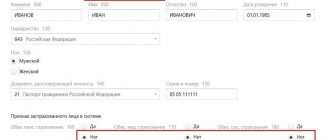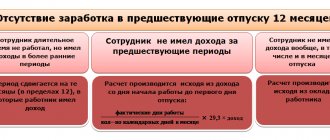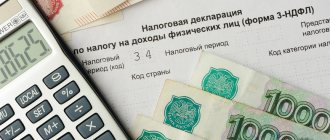The tax burden is one of the main indicators by which a certain minimum payment of contributions to the budget is calculated. If, based on the results of its activities, an enterprise does not “reach” the minimum in its field, then this may become a reason for an on-site audit by the tax authorities. The Federal Tax Service has published on its website new values of the tax burden by type of economic activity for 2021. Tatyana Amelina, General Director, explains what has changed and how to calculate your tax burden.
Absolute and relative tax burden
The concept of tax burden is used to establish the financial obligations of an entrepreneur to the state. It can be viewed as a relative or absolute value.
The amount burdening the entrepreneur due to his duties as a taxpayer, expressed in a certain figure, constitutes the absolute value of the tax burden.
Entrepreneurs need to know this figure in order to plan the ratio of expenses and income, optimize the business, and evaluate its profitability.
Tax authorities interpret the tax burden as a measure characterizing the funds that an entrepreneur allocates from business for his tax expenses. This approach is relative, as it includes many parameters taken into account by the Federal Tax Service.
That is why the relative designation of the tax burden better allows us to analyze the impact of the tax burden on the financial condition of the entrepreneur and the profitability of his business.
Sometimes the tax burden is identified with the effective tax rate - a percentage of the actual payment of a particular tax in the total tax base.
When it comes to the tax burden for a specific tax, it is permissible to apply this definition, which is what is done in some regulations.
What influences the ability to choose a tax system
The tax regime depends on various factors. For example, not every company can work on the simplified tax system if the indicators do not meet certain criteria.
The taxation system is selected when registering with the tax authorities. In some cases, taxpayers may voluntarily change regimes during the course of their activities. And sometimes you have to change the system due to changes in the financial performance of the company.
To choose a tax regime, you should take into account and analyze a number of indicators: field of activity, company size, planned income, book value of property, customer requests (for example, some buyers refuse to work with companies not on OSNO because they want to receive a VAT refund) and other indicators .
If the taxation system is not specified in the application for registration with the Federal Tax Service, OSNO will be assigned by default. This is due to the fact that absolutely all organizations and individual entrepreneurs can work on this system. Accounting on the general system is very labor-intensive; you need to take into account a lot of nuances in order to comply with the law. The tax burden will also be quite high.
However, for large companies with high incomes and large staff, OSNO is the only available option.
Representatives of small and medium-sized businesses were luckier. Here, many have a choice of special modes. UTII can only be used by enterprises with a certain type of activity. Very soon they will have to choose a different regime, since starting from 01/01/2021, UTII will be cancelled.
The most famous special regime is the simplified tax system. The advantage of this system is the relative simplicity of accounting. Entrepreneurs often cope with accounting without the help of an accountant. Tax on the simplified tax system is paid on income or on the difference between income and expenses. To work on a simplified system, the number of employees must be within 100 people, and the income should not exceed 150 million rubles per year. There are also a number of restrictions for working on the simplified tax system (Chapter 26.2 of the Tax Code of the Russian Federation).
The patent system, like UTII, cannot be used by everyone. But the scope for obtaining a patent is extensive (Article 346.43 of the Tax Code of the Russian Federation).
State documents
Since the tax burden ranks first among the criteria for selecting the “lucky” ones for an on-site tax audit, its documentary regulation relates primarily to documents issued by the Federal Tax Service. The relations between tax payers and regulatory authorities are regulated by the following acts:
- Order of the Federal Tax Service of the Russian Federation “On approval of the Concept of the planning system for on-site tax audits” dated May 30, 2007 No. MM-3-06/333 and its Appendix No. 3 - information data that is replenished and updated annually;
- Letter of the Federal Tax Service of the Russian Federation “On the work of commissions of tax authorities on the legalization of the tax base” dated July 17, 2013 No. AS-4-2/12722 contains a formula for calculating the tax burden for various types of taxes and special tax regimes.
NOTE! All this information is contained on the official website of the Federal Tax Service.
Who needs it and why?
Determining how much money is spent on taxes is an important point that determines the activities of economic entities at various levels:
- taxpayers themselves can assess the effectiveness of their activities, determine how great the risk of a tax audit is, decide on the optimal tax regime, and predict further actions;
- The federal tax service uses these figures to design its regulatory activities, and also has the opportunity to influence the modernization of the tax system as a whole;
- The Ministry of Finance and other economic government agencies, based on tax burden indicators, study the economic situation at the regional and state levels, planning and forecasting the country's future financial policy.
What kind of load will we consider?
The mentioned documents, in addition to informational information, can give entrepreneurs the opportunity to independently calculate the tax burden using specially developed formulas.
The first document (order of the Federal Tax Service) provides a general formula that will help in calculating the total tax burden , that is, the share of funds that were accrued for payment on the basis of tax returns in relation to the amount of revenue recorded by Goskomstat (in the income statement) .
IMPORTANT! Personal income tax is included in the calculation of such a load, but VAT is not. At the same time, contributions to extra-budgetary funds are excluded from the calculations, since not all of them are supervised by the Federal Tax Service.
The second document (letter from the Federal Tax Service) contains several calculation formulas for different taxes and certain special tax regimes.
Decrease in indicator: what will happen
If the value of the indicator is below the average for a specific type of activity, then the Federal Tax Service has the right:
- Call the head of the company for a personal conversation. The meeting will be conducted by the head of the Federal Tax Service at the place of registration or his deputies. During the conversation, a representative of the Federal Tax Service will find out the reason for the reduction in the fiscal burden. The main purpose of the meeting: to identify shell companies, unscrupulous taxpayers, illegal transactions and operations.
- Initiate an on-site inspection. The inspectorate will include the “problem” taxpayer in the plan of control and audit activities, during which it will: conduct a thorough check of accounting and tax records, study primary and accounting documents confirming the facts of economic activity.
If a company evades compliance with the requirements of the Federal Tax Service, inspectors have the right to use more effective methods of influence. Moreover, such methods can have a negative impact on the activities of the subject. For example, in exceptional cases, the Federal Tax Service may freeze the accounts of an enterprise. That is, any financial transactions will be impossible. Officials can also turn to the courts to initiate administrative or even criminal prosecution for tax evasion and other fiscal payments.
Formula for calculating the tax burden
Cumulative load
The total tax burden is calculated on a very average basis. Its formula is extremely simple: it is a quotient of tax deductions and revenues. In a more refined version, it might look like this:
НН = СнОг x 100% / СВг - VAT,
Where:
TN – tax burden; SnOg – the amount of taxes paid according to the report in the tax year; СВг – the amount of revenue according to accounting documents corresponding to the tax annual period; it does not include VAT and excise taxes. This technique was developed and recommended for use by the Ministry of Finance of the Russian Federation.
The load will be considered low and will attract close attention from the tax authorities if the calculated indicator is less than the industry average values updated annually on the Federal Tax Service website.
FOR YOUR INFORMATION! There are other methods for calculating the tax burden in the aggregate, proposed in various economic publications.
EXAMPLE. Let's calculate the workload of the conditional Dolgozhdan LLC, which is engaged in the hotel business.
The Federal Tax Service has determined the average load level for this type of business as 9%.
The company's revenue, according to the financial report for 2015, amounted to 40 million rubles. Tax returns filed by the firm this year showed the following tax deductions:
- VAT – 1.1 million rubles;
- income tax – 1.2 million rubles;
- corporate property tax – 520 thousand rubles;
- transport tax – 250 thousand rubles.
Personal income tax was withheld from employee salaries in the amount of 750 thousand rubles. Insurance premiums, as well as transfers to the Pension Fund, have no significance for this calculation.
Tax burden of Dolgozhdan LLC : 1,100,000 + 1,200,000 + 520,000 + 250,000 + 750,000 = 2,625,000 rubles. Divide by the profit indicator: 2,625,000 / 40,000,000 = 0.065. Multiply by 100%, we get 6.5%.
The calculated result is less than the average (9%) determined by the Federal Tax Service for this business sector. Therefore, Dolgozhdan LLC will be included in the plan of on-site tax audits, or its employees will be called to the tax office to give explanations.
Load for a specific tax
Most often, the tax burden is calculated using VAT and income tax.
Level of income tax burden
The Federal Tax Service will be alert if it is below the following indicators:
- for trade enterprises – less than 1%;
- for other organizations, including those involved in production and contracting - less than 3%.
It is calculated using the following formula:
ННп = Нп / (Др + Двн),
where: ННп – tax burden for income tax; Np – income tax based on the results of the annual declaration; Др – income from sales, determined according to the profit declaration data; Dvn – other (non-operating) income of the organization according to the same declaration. The result obtained is multiplied by 100%.
Level of tax burden for VAT
The Federal Tax Service recognizes the level of tax burden for VAT as low if for all four quarters of the reporting year the amount of tax deductions for VAT amounts to 89% or more of the total amount of this tax.
There are several ways to calculate the VAT burden.
- Divide the amount of VAT paid (NVAT) into the tax base indicators in accordance with section 3 of the corresponding declaration, focusing on the state of the Russian market (NBrf): Tax
Tax on VAT = NNDS / NBRf - Find the ratio of the amount of VAT according to the declaration (NVAT) to the total tax base, which includes both indicators of the Russian market and the export market (NBtot):
NV for VAT = NNAT / Nbtot.
How to act
So, let’s assume that your company has a high level of fiscal deductions for VAT. In this case, proceed in order:
- Prepare explanations. A high level of VAT deductions is not a crime. They are not accusing you of anything, but simply want to check whether you are applying the current legislation correctly. There's no need to panic. Prepare detailed and detailed explanations of the circumstances.
- If explanations to the tax authorities are not enough and you are invited to the inspectorate for a conversation, then you should not avoid the meeting. Show up with your passport at the appointed time. If necessary, take your constituent documents with you. Answer all questions. A conversation with a representative of the Federal Tax Service is a certain type of check that allows you to find out whether the company is a one-day company.
- If a personal meeting did not convince you, and the Federal Tax Service initiated on-site control, then you should not despair. Inspectors will check documentation (contracts, invoices, purchase and sales books). Help the controllers; there is no need to create obstacles.
Let us remind you that a high level of VAT deductions is not a crime. The Federal Tax Service has the right to assess additional tax only on the basis of violations identified as a result of an on-site inspection.
Nuances of the tax burden for different types of entrepreneurs
- IP . An individual entrepreneur must calculate the tax burden for personal income tax. To do this, you need to divide the indicator in your declaration by the 3-NDFL given in the declaration.
- Payers of the simplified tax system must take the level of their load accrued in accordance with the declaration and divide it by income in accordance with 3-NDFL.
- Entrepreneurs on the unified agricultural tax divide, accordingly, their tax indicators by the amount of income according to the 3-NDFL declaration.
- Those who chose OSNO add up VAT and income tax and find the ratio of the amount received to the total revenue reflected in the income statement.
IMPORTANT INFORMATION! If a businessman, in addition to those listed, pays other taxes, for example, land, water, property, etc. (except for personal income tax), then all these taxes will participate in the calculation of the total burden.
If the level of the tax burden turns out to be low, this does not mean mandatory penalties: they can only be imposed based on the results of an audit, the risk of which naturally increases in such a situation.
Bank checks
Banks monitor the minimum tax indicator, the value of which is set at 0.5% of receipts to the current account by the Methodological Recommendations, approved. Bank of Russia 04/13/2016 No. 10-MR.
If the total amount of payments for taxes, fees and charges is less, the bank may request explanations, declarations, financial statements, contracts and other documents.
It is also recommended to accompany the submission of documents to the bank with an explanatory note explaining the situation.
This is what an explanation about a low tax burden might look like: a sample for a bank.









